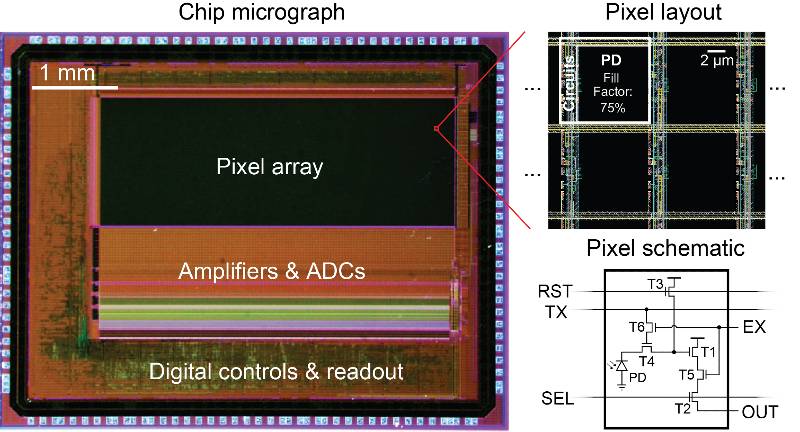Neurons, the fundamental building blocks of the brain, communicate through electrical signals, and understanding how they produce complex brain functions like memory requires tracking their voltage changes on the timescale of milliseconds. A team of MIT researchers, led by Jie Zhang, a postdoctoral scholar in The Picower Institute for Learning and Memory lab of Sherman Fairchild Professor Matt Wilson, has developed a novel image sensor that substantially improves the ability to capture these subtle voltage fluctuations.
The new invention, described in a recent paper published in Nature Communications, is a unique take on the standard “CMOS” technology used in scientific imaging. Unlike the conventional approach, where all pixels turn on and off simultaneously, the new chip allows for individual control of each pixel’s timing. This arrangement provides the best of both worlds, enabling neighboring pixels to complement each other by capturing all available light without compromising speed.
Capturing Single-Spike Resolution for Decoding Brain Processes
In experiments outlined in the study, Zhang and Wilson’s team demonstrates how “pixelwise” programmability allowed them to improve the visualization of neural voltage “spikes”—the signals neurons use to communicate with each other—and even the more subtle, momentary voltage fluctuations that occur between spiking events.
“Measuring with single-spike resolution is really important as part of our research approach,” said senior author Wilson, a Professor in MIT’s Departments of Biology and Brain and Cognitive Sciences (BCS), whose lab studies how the brain encodes and refines spatial memories both during wakeful exploration and during sleep. “Thinking about the encoding processes within the brain, single spikes and the timing of those spikes is important in understanding how the brain processes information.”
Overcoming Limitations of Conventional CMOS Image Sensors
While genetically encoded voltage indicators (GEVIs) have been developed to make cells glow as their voltage changes in real-time, Zhang and Wilson found that conventional CMOS image sensors were missing a lot of the action. If they operated too fast, they wouldn’t gather enough light, and if they operated too slow, they’d miss rapid changes.
Recognizing that there was resolution to spare, Zhang applied his expertise in sensor design to invent an image sensor chip that would enable neighboring pixels to each have their own timing. Faster ones could capture rapid changes, while slower-working ones could gather more light, ensuring that no action or photons would be missed. Zhang also cleverly engineered the required control electronics to barely cut into the space available for light-sensitive elements on a pixel, ensuring the sensor’s high sensitivity under low light conditions.
The researchers demonstrated two ways in which the chip improved imaging of voltage activity of mouse hippocampus neurons cultured in a dish, running their sensor head-to-head against an industry standard scientific CMOS image sensor chip. The experiments showed that the pixelwise chip detected neural spiking activities that the conventional sensor missed and better matched the electrical readings made with a traditional patch clamp electrode. Furthermore, the pixelwise chip was able to capture both fast spiking and slower subthreshold changes by varying the exposure durations of neighboring pixels.
While the experiments with small clusters of neurons in a dish were only a proof-of-concept, Wilson said his lab’s ultimate goal is to conduct brain-wide, real-time measurements of activity in distinct types of neurons in animals even as they are freely moving about and learning how to navigate mazes. The development of GEVIs and image sensors like the pixelwise chip that can successfully take advantage of what they show is crucial to making that goal feasible.
“That’s the idea of everything we want to put together: large-scale voltage imaging of genetically tagged neurons in freely behaving animals,” Wilson said.
To achieve this, Zhang added, “We are already working on the next iteration of chips with lower noise, higher pixel counts, time-resolution of multiple kHz, and small form factors for imaging in freely behaving animals.”
The research, advancing pixel by pixel, is paving the way for groundbreaking insights into how the brain functions and processes information.
If our reporting has informed or inspired you, please consider making a donation. Every contribution, no matter the size, empowers us to continue delivering accurate, engaging, and trustworthy science and medical news. Independent journalism requires time, effort, and resources—your support ensures we can keep uncovering the stories that matter most to you.
Join us in making knowledge accessible and impactful. Thank you for standing with us!

